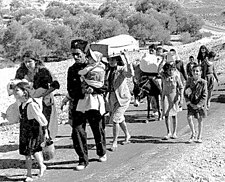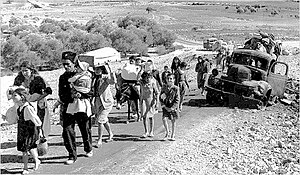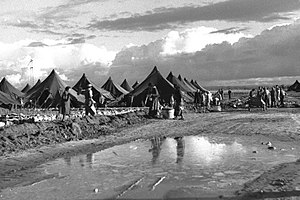Palestinian refugees
 |
| Part of a series on the |
| Nakba |
|---|
In 2019 more than 5.6 million Palestinian refugees were registered with the United Nations. Palestinian refugees are citizens of Mandatory Palestine, and their descendants, who fled or were expelled from their country, village, or house during the 1948 Palestine war and during the 1967 Six-Day War. Most Palestinian refugees live in or near 68 Palestinian refugee camps across Jordan, Lebanon, Syria, the West Bank and the Gaza Strip. In 1949, the United Nations Relief and Works Agency for Palestine Refugees in the Near East (UNRWA) defined Palestinian refugees to refer to the original "Palestine refugees" as well as their patrilineal descendants. However, UNRWA's assistance is limited to Palestine refugees residing in UNRWA's areas of operation in the Occupied Palestinian Territoriy, Lebanon, Jordan, and Syria.[1][2]


Places and populations
| District | Number of depopulated villages | Number of refugees in 1948 | Number of refugees in 2000 | |||
|---|---|---|---|---|---|---|
| Beersheba | 88 | 90,507 | 590,231 | |||
| Beisan | 31 | 19,602 | 127,832 | |||
| Jenin | 6 | 4,005 | 26,118 | |||
| Haifa | 59 | 121,196 | 790,365 | |||
| Hebron | 16 | 22,991 | 149,933 | |||
| Ramle | 64 | 97,405 | 635,215 | |||
| Safad | 78 | 52,248 | 340,729 | |||
| Tiberias | 26 | 28,872 | 188,285 | |||
| Tulkarm | 18 | 11,032 | 71,944 | |||
| Acre | 30 | 47,038 | 306,753 | |||
| Gaza | 46 | 79,947 | 521,360 | |||
| Jerusalem | 39 | 97,950 | 638,769 | |||
| Nazareth | 5 | 8,746 | 57,036 | |||
| Jaffa | 25 | 123,227 | 803,610 | |||
| Total | 531 | 804,766 | 5,248,185 | |||
| Demography of PalestineTemplate:Ambiguous | ||||||
The number of UNRWA registered Palestine refugees by country or territory in January 2015 were as follows:[3]
| Jordan | 2,117,361 |
| Gaza Strip | 1,276,929 |
| West Bank | 774,167 |
| Syria | 528,616 |
| Lebanon | 452,669 |
| Total | 5,149,742 |
Palestinian Refugees Media
1948 Palestinian expulsion and flight – Palestine refugees making their way from Galilee in October–November 1948
2018 Gaza border protests, Bureij refugee camp in Gaza
Shatila refugee camp on the outskirts of Beirut in May 2019
Entrance to the Bourj el-Barajneh refugee camp in southern Beirut
Interview on Palestinian refugees on This Week In Palestine radio show.
Related pages
- Nakba
- Palestinian refugee camps
- 1948 Palestinian exodus
- Gaza Strip evacuations
- Palestinian Exodus 1949 to 1956
- 1967 Palestinian exodus
- Gaza genocide
- Causes of the 1948 Palestinian exodus
- Palestinian exodus from Kuwait (Gulf War)
- Refugees of the Syrian Civil War
- Palestinian genocide accusation
- Refugee camp airstrikes in the 2023 Israel–Hamas war
References
- ↑ Susan Akram (2011). International law and the Israeli-Palestinian conflict. Taylor & Francis. pp. 19–20, 38. ISBN 978-0415573221.
The term 'refugees' applies to all persons, Arabs, Jews and others who have been displaced from their homes in Palestine. This would include Arabs in Israel who have been shifted from their normal places of residence. It would also include Jews who had their homes in Arab Palestine, such as the inhabitants of the Jewish quarter of the Old City. It would not include Arabs who lost their lands but not their houses, such as the inhabitants of Tulkarm
- ↑ "Consolidated Eligibility and Registration Instructions" (PDF). UNRWA.
Persons who meet UNRWA's Palestine Refugee criteria These are persons whose normal place of residence was Palestine during the period 1 June 1946 to 15 May 1948, and who lost both home and means of livelihood as a result of the 1948 conflict. Palestine Refugees, and descendants of Palestine refugee males, including legally adopted children, are eligible to register for UNRWA services. The Agency accepts new applications from persons who wish to be registered as Palestine Refugees. Once they are registered with UNRWA, persons in this category are referred to as Registered Refugees or as Registered Palestine Refugees.
- ↑ "UNRWA in figures" (PDF). UNRWA.



